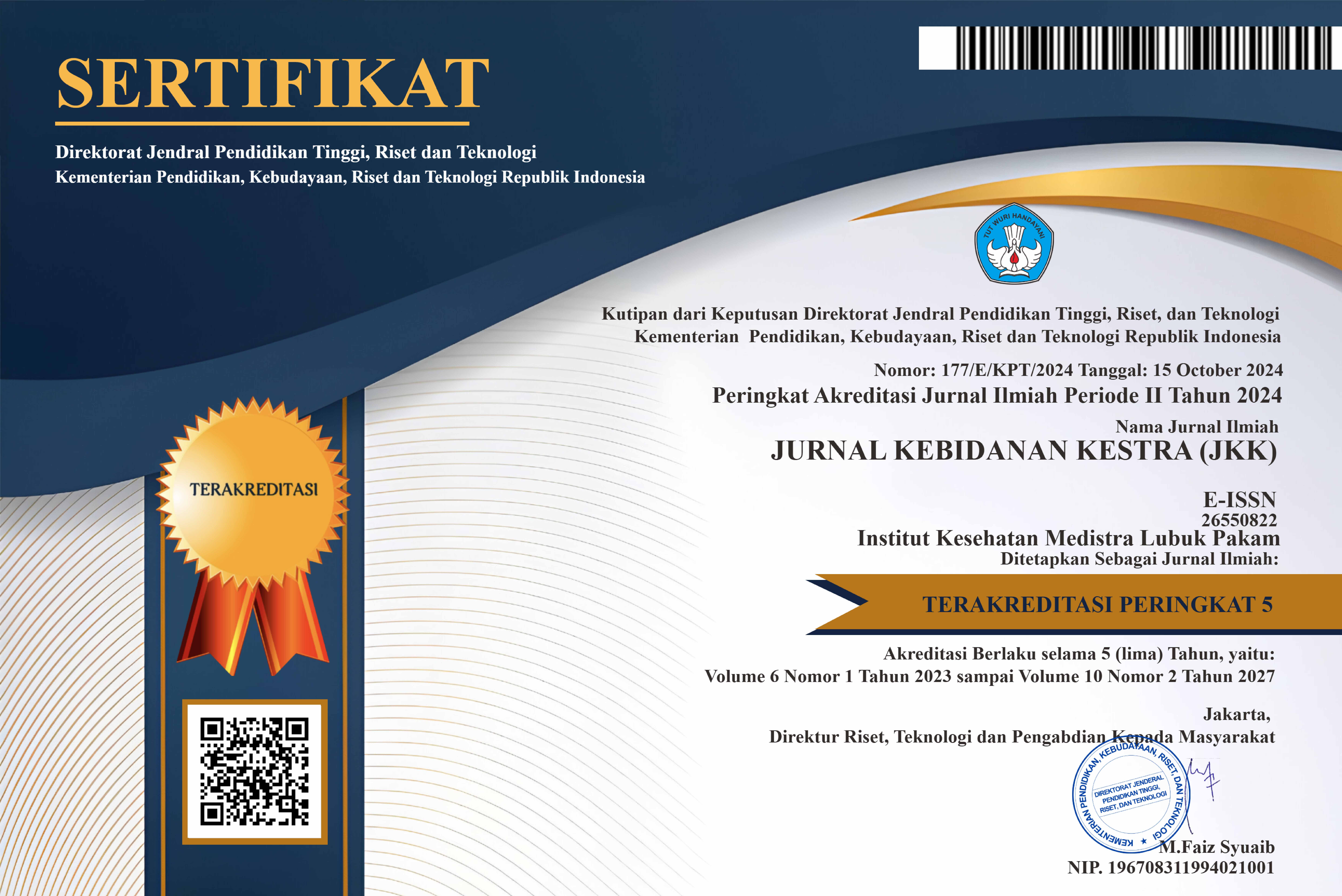Comparison of Hemoglobin Levels of Spontaneous Postpartum Mothers and Caesarean Section at RS. Grandmed and Clinic Pratama Nining Pelawati Lubuk Pakam
DOI:
https://doi.org/10.35451/jkk.v5i2.1556Keywords:
hemoglobin level, postpartum mother spontaneous and caesarean section.Abstract
Concurring to the World Health Organization (WHO) in (Fatimah 2020), that in creating nations the number of maternal passings amid pregnancy, childbirth and the puerperium is still tall, in Indonesia in 2019 the maternal mortality rate is 305/100,000 live births. Around the world, information on the predominance ofpostpartum frailty are constrained. Thinks bout conducted in high-income nations have detailed that 10-30% of postpartum ladies are frail (WH0, 2016). The predominance of iron deficiency in postpartum moms (Urban Puducherry, 2019) was 76.2% (n= 173, 95% Cl: 70.4%-81.4%). Roughly 26% (59) had mellow iron deficiency, 49.8% (113) had direct iron deficiency and 0.4% (1) had extreme iron deficiency. The investigate The investigate was carried out by comparative examination with a quantitative approach.The ask approximately test summed to 52 pregnant women respondents with coincidental reviewing strategy, examination test utilizing combined test. The comes around of this consider showed up that there was a critical qualification within the normal hemoglobin level of unconstrained parturition and sectio caesarea of 1.611537. With an normal hemoglobin level of unconstrained parturition moms of 11.13846 and moms of sectio caesarea of 9.526923. Based on the comes about of the t-test, the sig esteem was gotten. = 0.000. To decide the contrast in hemoglobin levels of unconstrained parturition moms and sectio caesarea. There are contrasts in hemoglobin levels in moms with unconstrained labor and sectio caesarea. So, it is anticipated for wellbeing laborers to carry out an examination of hemoglobin levels in postpartum mothers.
Downloads
References
Damayanti I. (2013). Umur, Paritas, dan Riwayat Obstetri dengan kejadian perdarahan Post partum. Jurnal Ilmu Kebidanan.1(3):6-140.
Departemen Gizi dan Kesehatan Masyarakat UI. (2016). Gizi dan Kesehatan Masyarakat. Jakarta : PT. Raja Grafindo Persada.
Dinas Kesejahteraan RI. (2018). Profil Kesehatan Indonesia Tahun 2018. (Jakarta: Balitbangkes).
Fatimah, (2020). Patologi Kehamilan. Yogyakarta: Pustaka Baru Press.
Iyengar, k. (2015, june). Early Postpartum Maternal Morbidity among Ruralwomen of Rajasthan, India: A Community-based Study. J HEALTH POPUL NUTR, 30(2), 213-225. doi:10.3329/jhpn.
Kiswari, R. (2014). Hematologi & Transfusi. Jakarta: Erlangga.
Manuaba, I. (2011). Ilmu Kebidanan Penyakit kandungan dan KB . Jakarta: EGC.
Marcelina, R., & Nisa , F. (2018). Hubungan Antara Pantang Makanan Dengan Penyembuhan Luka Perineum Di Ruang Mawar RSI Jemursari Surabaya. The Indonesian Journal of Health Science, 10(2), 101-109. Retrieved from https://doi.org/10.32528/ijhs.
Prawirohardjo, S. (2016). Ilmu Kebidanan. Jakarta: Yayasan Bina Pustaka Sarwono Prawihardjo.
Rukiyah, Y., & Yulianti, L. (2010). Asuhan Kebidanan Patologi Kebidanan. Jakarta : Trans Info Media.
Sherwood L. (2013) Fisiologi Manusia dari Sel ke Sistem. Jakarta: EGC.
Sudikno, S., & Sandjaja, S. (2016). Pravalensi Dan Faktor Risiko Anemia Pada WUS Di Kabupaten Tasikmalaya Dan Ciamis, Provinsi Jawa Barat. Jurnal Kespro, 7(2), 71-82.
Taylor, D. (2014). PUERPERAL HAEMATOLOGICAL INDICES. British Journalof Obstetrics and Gynaecology, 88, 601-606..
Wijarnarko, E (2017). Asuhan Kebidanan Pada Kehamilan. Yogyakarta: Pustaka Baru Press.
Widatiningsih, S., & Cristin, H. (2017). Praktik Terbaik Asuhan Kebidanan . Yogyakarta: Trans Media.
Zhao, A., Zhang , J., Wu, W., Wang , P., & Zhang, Y. (2019). Postpartum anemia is a neglected public health issue in China. Asia Pacific Journal of Clinical Nutrition, 28(4), 793-799. Retrieved from http://doi.org/10.6133/apjcn.201912.
Downloads
Published
Issue
Section
License
Copyright in each article is the property of the Author.



























